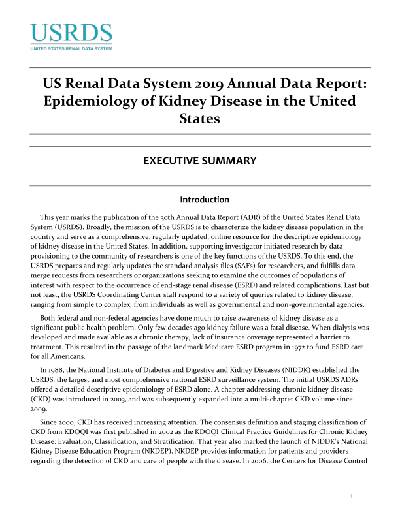"肾脏病数据报告"相关数据
更新时间:2023-10-10This year marks the publication of the 3oth Annual Data Report (ADR) of the United States Renal DataSystem (USRDS)。 Broadly, the mission of the USRDS is to characterize the kidney disease population in thecountry and serve as a comprehensive, regularly updated, online resource for the descriptive epidemiologyof kidney disease in the United States。 In addition, supporting investigator initiated research by dataprovisioning to the community of researchers is one of the key functions of the USRDS。 To this end, theUSRDS prepares and regularly updates the standard analysis files (SAFs) for researchers, and fulfills datamerge requests from researchers or organizations seeking to examine the outcomes of populations ofinterest with respect to the occurrence of end-stage renal disease (ESRD) and related complications。 Last butnot least, the USRDS Coordinating Center staff respond to a variety of queries related to kidney disease,ranging from simple to complex, from individuals as well as governmental and non-governmental agencies。
Both federal and non-federal agencies have done much to raise awareness of kidney disease as a
significant public health problem。 Only few decades ago kidney failure was a fatal disease。 When dialysis wasdeveloped and made available as a chronic therapy, lack of insurance coverage represented a barrier totreatment。 This resulted in the passage of the landmark Medicare ESRD program in 1972 to fund ESRD carefor all Americans。
In 1988, the National Institute of Diabetes and Digestive and Kidney Diseases (NIDDK) established theUSRDS, the largest and most comprehensive national ESRD surveillance system。The initial USRDS ADRsoffered a detailed descriptive epidemiology of ESRD alone。 A chapter addressing chronic kidney disease(CKD) was introduced in 2003, and was subsequently expanded into a multi-chapter CKD volume since2009。
Since 2000, CKD has received increasing attention。 The consensus definition and staging classification ofCKD from KDOQI was first published in 2002 as the KDOQI Clinical Practice Guidelines for Chronic KidneyDisease: Evaluation, Classification, and Stratification。 That year also marked the launch of NIDDK's NationalKidney Disease Education Program (NKDEP)。 NKDEP provides information for patients and providersregarding the detection of CKD and care of people with the disease。 In 2006, the Centers for Disease Controland Prevention launched a broad CKD initiative, with the CDC CKD Surveillance System as its majorcomponent。 This project prioritizes the earlier stages of CKD, as opposed to ESRD, or the late transitions ofcare from advanced stages of CKD to ESRD。
In the 201g ADR, we continue to characterize the spectrum of CKD and ESRD patient populations, anddescribe the distributions of patients by attributes such as age, sex, race, and comorbid conditions。
【更多详情,请下载:美国肾脏病数据系统2019年年度报告】

 1996-2017年美国以糖尿病为首要病因按年龄,性别,种族,民族分类的所有终末期肾脏病新患者(不包括未知和其他(多个)种族)统计情况以糖尿病为首要病因,美国所有患者(不包括未知和其他(多个)种族)1996-2017年发布时间:2020-03-09
1996-2017年美国以糖尿病为首要病因按年龄,性别,种族,民族分类的所有终末期肾脏病新患者(不包括未知和其他(多个)种族)统计情况以糖尿病为首要病因,美国所有患者(不包括未知和其他(多个)种族)1996-2017年发布时间:2020-03-09 1996-2017年美国以糖尿病为主要病因的终末期肾脏病按年龄,性别,种族,民族分类的所有患者(不包括未知和其他(多个)种族)统计情况性别和种族不明,未知和其他/多种族种族均没有包括1996-2017年发布时间:2020-03-09
1996-2017年美国以糖尿病为主要病因的终末期肾脏病按年龄,性别,种族,民族分类的所有患者(不包括未知和其他(多个)种族)统计情况性别和种族不明,未知和其他/多种族种族均没有包括1996-2017年发布时间:2020-03-09 1996-2017年美国以囊性肾为主要病因的终末期肾脏病按年龄,性别,种族,民族分类的所有患者(不包括未知和其他(多个)种族)统计情况性别和种族不明,未知和其他/多种族种族均没有包括1996-2017年发布时间:2020-03-09
1996-2017年美国以囊性肾为主要病因的终末期肾脏病按年龄,性别,种族,民族分类的所有患者(不包括未知和其他(多个)种族)统计情况性别和种族不明,未知和其他/多种族种族均没有包括1996-2017年发布时间:2020-03-09 1996-2017年美国以囊性肾为首要病因按年龄,性别,种族,民族分类的所有终末期肾脏病新患者(不包括未知和其他(多个)种族)统计情况以囊性肾为首要病因,美国所有患者(不包括未知和其他(多个)种族)1996-2017年发布时间:2020-03-09
1996-2017年美国以囊性肾为首要病因按年龄,性别,种族,民族分类的所有终末期肾脏病新患者(不包括未知和其他(多个)种族)统计情况以囊性肾为首要病因,美国所有患者(不包括未知和其他(多个)种族)1996-2017年发布时间:2020-03-09 1996-2017年美国以肾小球肾炎为主要病因的终末期肾脏病按年龄,性别,种族,民族分类的所有患者(不包括未知和其他(多个)种族)统计情况性别和种族不明,未知和其他/多种族种族均没有包括1996-2017年发布时间:2020-03-09
1996-2017年美国以肾小球肾炎为主要病因的终末期肾脏病按年龄,性别,种族,民族分类的所有患者(不包括未知和其他(多个)种族)统计情况性别和种族不明,未知和其他/多种族种族均没有包括1996-2017年发布时间:2020-03-09 1996-2017年美国以肾小球肾炎为首要病因按年龄,性别,种族,民族分类的所有终末期肾脏病新患者(不包括未知和其他(多个)种族)统计情况以肾小球肾炎为首要病因,美国所有患者(不包括未知和其他(多个)种族)1996-2017年发布时间:2020-03-09
1996-2017年美国以肾小球肾炎为首要病因按年龄,性别,种族,民族分类的所有终末期肾脏病新患者(不包括未知和其他(多个)种族)统计情况以肾小球肾炎为首要病因,美国所有患者(不包括未知和其他(多个)种族)1996-2017年发布时间:2020-03-09 1996-2017年美国主要因糖尿病导致终末期肾脏病按年龄,性别,种族和民族分类的每1百万人口中患者(不包括未知和其他(多个)种族)统计情况所有经年龄,性别,种族,民族调整过的美国患者;性别和种族不明,未知和其他/多种族种族均没有包括1996-2017年发布时间:2020-03-09
1996-2017年美国主要因糖尿病导致终末期肾脏病按年龄,性别,种族和民族分类的每1百万人口中患者(不包括未知和其他(多个)种族)统计情况所有经年龄,性别,种族,民族调整过的美国患者;性别和种族不明,未知和其他/多种族种族均没有包括1996-2017年发布时间:2020-03-09 1996-2017年美国主要因囊性肾导致终末期肾脏病按年龄,性别,种族和民族分类的每1百万人口中患者(不包括未知和其他(多个)种族)统计情况所有经年龄,性别,种族,民族调整过的美国患者;性别和种族不明,未知和其他/多种族种族均没有包括1996-2017年发布时间:2020-03-09
1996-2017年美国主要因囊性肾导致终末期肾脏病按年龄,性别,种族和民族分类的每1百万人口中患者(不包括未知和其他(多个)种族)统计情况所有经年龄,性别,种族,民族调整过的美国患者;性别和种族不明,未知和其他/多种族种族均没有包括1996-2017年发布时间:2020-03-09 1996-2017年美国主要因糖尿病导致终末期肾脏病按年龄,性别,种族和民族分类的每1百万人口中新患者(不包括未知和其他(多个)种族)统计情况所有经年龄,性别,种族,民族调整过的美国患者;性别和种族不明,未知和其他/多种族种族均没有包括1996-2017年发布时间:2020-03-09
1996-2017年美国主要因糖尿病导致终末期肾脏病按年龄,性别,种族和民族分类的每1百万人口中新患者(不包括未知和其他(多个)种族)统计情况所有经年龄,性别,种族,民族调整过的美国患者;性别和种族不明,未知和其他/多种族种族均没有包括1996-2017年发布时间:2020-03-09 1996-2017年美国主要因肾小球肾炎导致终末期肾脏病按年龄,性别,种族和民族分类的每1百万人口中患者(不包括未知和其他(多个)种族)统计情况所有经年龄,性别,种族,民族调整过的美国患者;性别和种族不明,未知和其他/多种族种族均没有包括1996-2017年发布时间:2020-03-09
1996-2017年美国主要因肾小球肾炎导致终末期肾脏病按年龄,性别,种族和民族分类的每1百万人口中患者(不包括未知和其他(多个)种族)统计情况所有经年龄,性别,种族,民族调整过的美国患者;性别和种族不明,未知和其他/多种族种族均没有包括1996-2017年发布时间:2020-03-09 1996-2017年美国主要因肾小球肾炎导致终末期肾脏病按年龄,性别,种族和民族分类的每1百万人口中新患者(不包括未知和其他(多个)种族)统计情况所有经年龄,性别,种族,民族调整过的美国患者;性别和种族不明,未知和其他/多种族种族均没有包括1996-2017年发布时间:2020-03-09
1996-2017年美国主要因肾小球肾炎导致终末期肾脏病按年龄,性别,种族和民族分类的每1百万人口中新患者(不包括未知和其他(多个)种族)统计情况所有经年龄,性别,种族,民族调整过的美国患者;性别和种族不明,未知和其他/多种族种族均没有包括1996-2017年发布时间:2020-03-09 1996-2017年美国主要因囊性肾导致终末期肾脏病按年龄,性别,种族和民族分类的每1百万人口中新患者(不包括未知和其他(多个)种族)统计情况所有经年龄,性别,种族,民族调整过的美国患者;性别和种族不明,未知和其他/多种族种族均没有包括1996-2017年发布时间:2020-03-09
1996-2017年美国主要因囊性肾导致终末期肾脏病按年龄,性别,种族和民族分类的每1百万人口中新患者(不包括未知和其他(多个)种族)统计情况所有经年龄,性别,种族,民族调整过的美国患者;性别和种族不明,未知和其他/多种族种族均没有包括1996-2017年发布时间:2020-03-09 1996-2017年美国领土地区按年龄,性别,种族,民族和主要导致终末期肾脏病原因分类的所有患者统计情况美国领土地区的所有患者1996-2017年发布时间:2020-03-09
1996-2017年美国领土地区按年龄,性别,种族,民族和主要导致终末期肾脏病原因分类的所有患者统计情况美国领土地区的所有患者1996-2017年发布时间:2020-03-09 1996-2017年美国以高血压为主要病因的终末期肾脏病按年龄,性别,种族,民族分类的所有患者(不包括未知和其他(多个)种族)统计情况性别和种族不明,未知和其他/多种族种族均没有包括1996-2017年发布时间:2020-03-09
1996-2017年美国以高血压为主要病因的终末期肾脏病按年龄,性别,种族,民族分类的所有患者(不包括未知和其他(多个)种族)统计情况性别和种族不明,未知和其他/多种族种族均没有包括1996-2017年发布时间:2020-03-09 1996-2017年美国以高血压为首要病因按年龄,性别,种族,民族分类的所有终末期肾脏病新患者(不包括未知和其他(多个)种族)统计情况以高血压为首要病因,美国所有患者(不包括未知和其他(多个)种族)1996-2017年发布时间:2020-03-09
1996-2017年美国以高血压为首要病因按年龄,性别,种族,民族分类的所有终末期肾脏病新患者(不包括未知和其他(多个)种族)统计情况以高血压为首要病因,美国所有患者(不包括未知和其他(多个)种族)1996-2017年发布时间:2020-03-09 1996-2017年美国领土地区按年龄,性别,种族,民族和主要导致终末期肾脏病原因分类的所有新患者统计情况美国领土地区的所有患者1996-2017年发布时间:2020-03-09
1996-2017年美国领土地区按年龄,性别,种族,民族和主要导致终末期肾脏病原因分类的所有新患者统计情况美国领土地区的所有患者1996-2017年发布时间:2020-03-09 1996-2017年美国主要因高血压导致终末期肾脏病按年龄,性别,种族和民族分类的每1百万人口中患者(不包括未知和其他(多个)种族)统计情况所有经年龄,性别,种族,民族调整过的美国患者;性别和种族不明,未知和其他/多种族种族均没有包括1996-2017年发布时间:2020-03-09
1996-2017年美国主要因高血压导致终末期肾脏病按年龄,性别,种族和民族分类的每1百万人口中患者(不包括未知和其他(多个)种族)统计情况所有经年龄,性别,种族,民族调整过的美国患者;性别和种族不明,未知和其他/多种族种族均没有包括1996-2017年发布时间:2020-03-09 1996-2017年美国主要因高血压导致终末期肾脏病按年龄,性别,种族和民族分类的每1百万人口中新患者(不包括未知和其他(多个)种族)统计情况所有经年龄,性别,种族,民族调整过的美国患者;性别和种族不明,未知和其他/多种族种族均没有包括1996-2017年发布时间:2020-03-09
1996-2017年美国主要因高血压导致终末期肾脏病按年龄,性别,种族和民族分类的每1百万人口中新患者(不包括未知和其他(多个)种族)统计情况所有经年龄,性别,种族,民族调整过的美国患者;性别和种族不明,未知和其他/多种族种族均没有包括1996-2017年发布时间:2020-03-09 1996-2017年美国领土地区按年龄,性别,种族,民族和主要导致终末期肾脏病原因分类的所有患者(不包括未知和其他(多个)种族)统计情况性别和种族不明,未知和其他/多种族种族均没有包括1996-2017年发布时间:2020-03-09
1996-2017年美国领土地区按年龄,性别,种族,民族和主要导致终末期肾脏病原因分类的所有患者(不包括未知和其他(多个)种族)统计情况性别和种族不明,未知和其他/多种族种族均没有包括1996-2017年发布时间:2020-03-09 1996-2017年美国领土地区按年龄,性别,种族,民族和主要导致终末期肾脏病原因分类的所有新患者(不包括未知和其他(多个)种族)统计情况性别和种族不明,未知和其他/多种族种族均没有包括1996-2017年发布时间:2020-03-09
1996-2017年美国领土地区按年龄,性别,种族,民族和主要导致终末期肾脏病原因分类的所有新患者(不包括未知和其他(多个)种族)统计情况性别和种族不明,未知和其他/多种族种族均没有包括1996-2017年发布时间:2020-03-09





